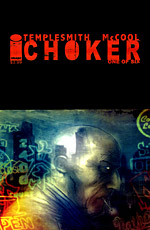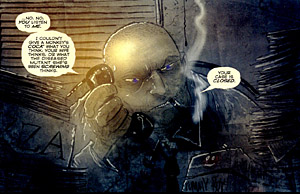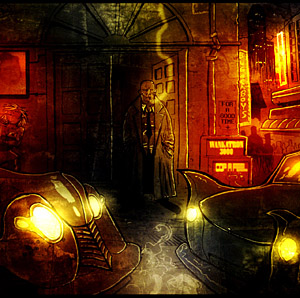 Written by Ben McCool
Written by Ben McCool
Art by Ben Templesmith
32 pages, color
Published by Image Comics
I know I’m not the only person who misses Fell, Warren Ellis and Ben Templesmith’s series for Image that quietly stopped publishing (for now) after nine issues. So while it probably isn’t fair to instantly start throwing out comparisons between Fell and Choker, I will admit that it was my missing of Fell that made me decide to check out Choker. While the two share an artist and a certain sensibility, though, it’s in the writing that the two series definitely part ways.
 Choker, perhaps by virtue of it being just a six-issue limited-series, is a book that has a stronger focus on plot right from the beginning. We quickly meet Johnny Jackson, a former cop turned into private investigator. As we follow him throughout Shotgun City, we learn about his situation and what he’s going to have to do for the rest of the mini-series. Ben McCool makes sure that is obvious that Jackson’s life is anything but good—so being given the opportunity to go back on the force in exchange for a favor makes sense, even if red flags are going off for the reader when it comes to the legitimacy of the deal. So while Fell was more about single bursts of story that all stand more or less alone, with Choker we’re being promised a longer, sustained story with subplots and a build towards a climax.
Choker, perhaps by virtue of it being just a six-issue limited-series, is a book that has a stronger focus on plot right from the beginning. We quickly meet Johnny Jackson, a former cop turned into private investigator. As we follow him throughout Shotgun City, we learn about his situation and what he’s going to have to do for the rest of the mini-series. Ben McCool makes sure that is obvious that Jackson’s life is anything but good—so being given the opportunity to go back on the force in exchange for a favor makes sense, even if red flags are going off for the reader when it comes to the legitimacy of the deal. So while Fell was more about single bursts of story that all stand more or less alone, with Choker we’re being promised a longer, sustained story with subplots and a build towards a climax.
That said, one thing I did find similar between the two series was that both pay close attention to setting-as-character. Shotgun City instantly feels like an entity in its own right, that sort of crime noir scene that’s been boiled down and then mixed with a bit of science-fiction. So we get the streets, the neighbors, the clubs, and the mad science all making an appearance in Choker. Part of it is certainly due to Templesmith’s art, but Shotgun City feels alive almost instantly. You get the distinct impression that McCool and Templesmith have mentally mapped out the city in terms of what it’s like to live there, what people do for fun, and which kind of person is not going to bolt from the city limits the second they hear a whisper of jobs elsewhere.
 Templesmith’s art is as breathtaking as always. His pencils and inks are impressive in their own right, giving Jackson an unattractive potato-shaped head that makes him stand out in a crowd, but one with surprisingly expressive eyes whenever they open wide in fear or shock or terror. From wrinkles around eyes to a double-chin, Templesmith draws no one as a fashion plate; they all look startlingly real and average and slightly run down. It’s a great way to populate Shotgun City, and it brings everything into stark focus. The one exception are the new cops with their Man Plus genetic enhancement program, all looking super-hero perfect with tight bodies and muscles. It’s this contrast that makes them stand out, where in other books they might have blended in. After all, it’s hard to recognize out of the ordinary when even the average person is being drawn well above average. Templesmith’s colors are the icing on the cake, though, with neon tubes glowing, street lights shining through exhaust and smoke, and a sickly yellow radiance coming from the office lighting. Templesmith shows as a back-up feature just how he puts all of his art together, and if anything I have even greater respect for his art now than I did before.
Templesmith’s art is as breathtaking as always. His pencils and inks are impressive in their own right, giving Jackson an unattractive potato-shaped head that makes him stand out in a crowd, but one with surprisingly expressive eyes whenever they open wide in fear or shock or terror. From wrinkles around eyes to a double-chin, Templesmith draws no one as a fashion plate; they all look startlingly real and average and slightly run down. It’s a great way to populate Shotgun City, and it brings everything into stark focus. The one exception are the new cops with their Man Plus genetic enhancement program, all looking super-hero perfect with tight bodies and muscles. It’s this contrast that makes them stand out, where in other books they might have blended in. After all, it’s hard to recognize out of the ordinary when even the average person is being drawn well above average. Templesmith’s colors are the icing on the cake, though, with neon tubes glowing, street lights shining through exhaust and smoke, and a sickly yellow radiance coming from the office lighting. Templesmith shows as a back-up feature just how he puts all of his art together, and if anything I have even greater respect for his art now than I did before.
Choker heads out of the great with a strong first issue; I’d forgotten how much I enjoy Templesmith’s art, and while this is the first comic I’ve read from McCool he’s definitely someone I’ll check out more from in the future. If they can keep this story rolling all the way to the conclusion, I’ll be impressed and pleased. Choker is the sort of comic that makes you tried something new.
